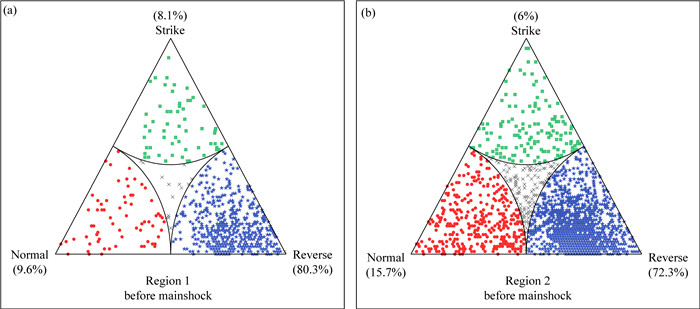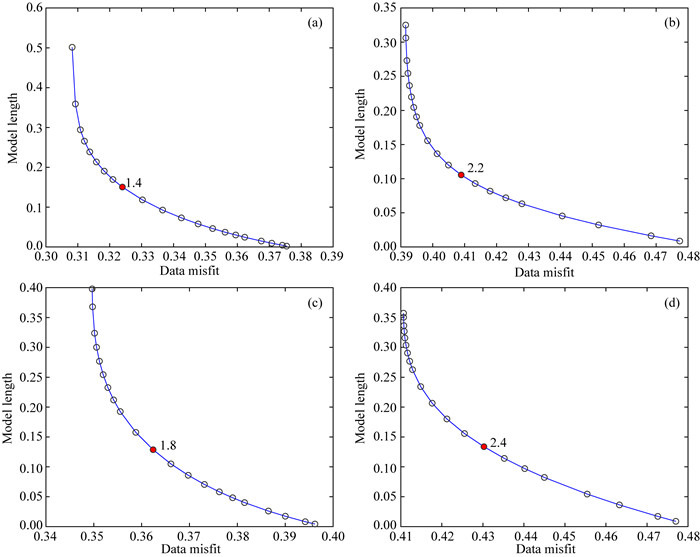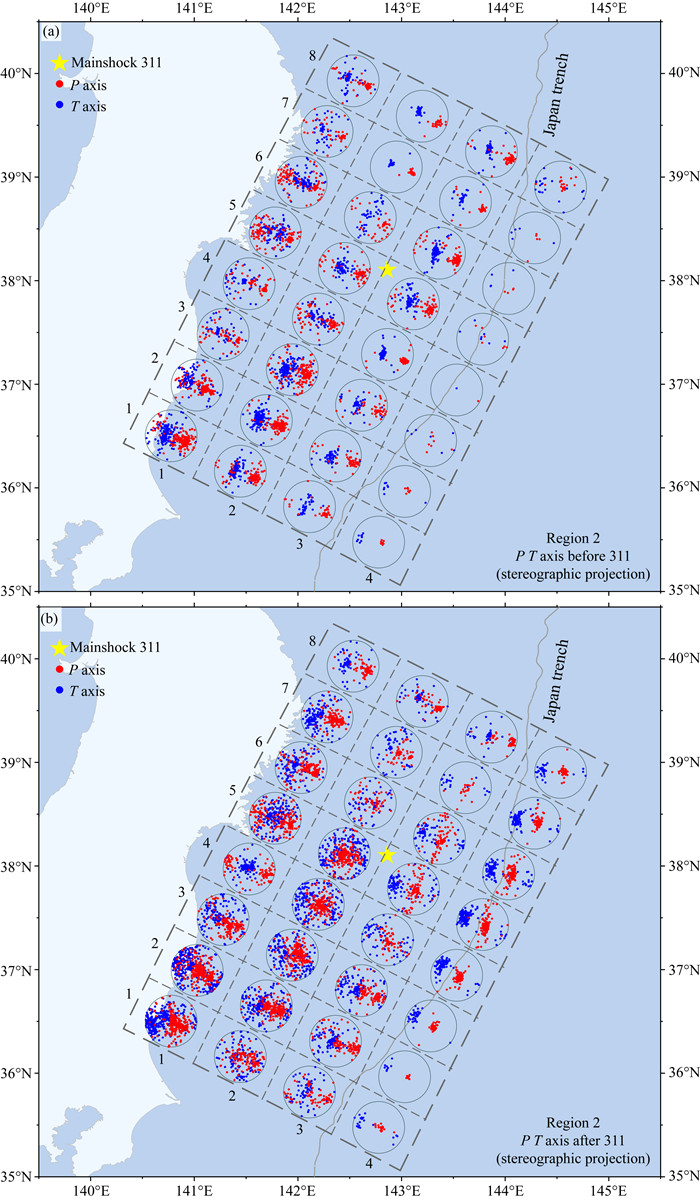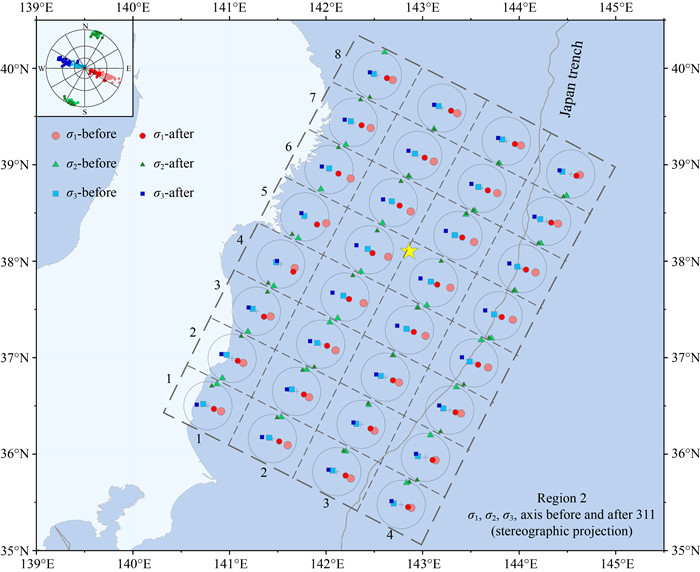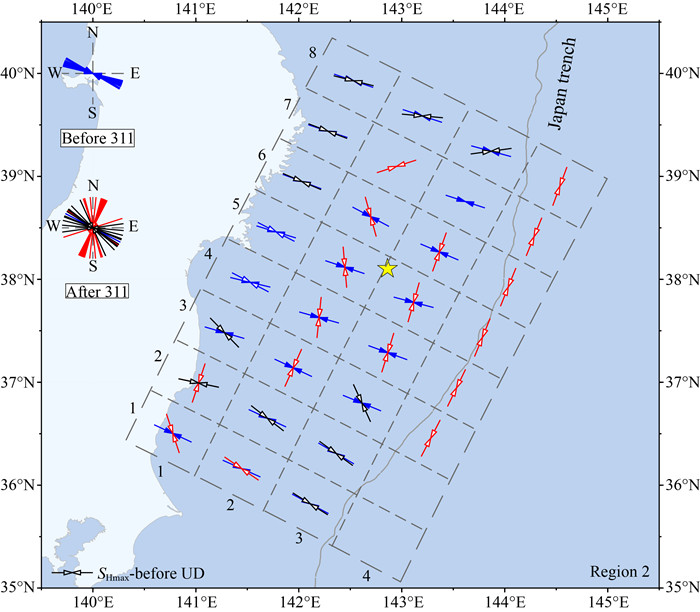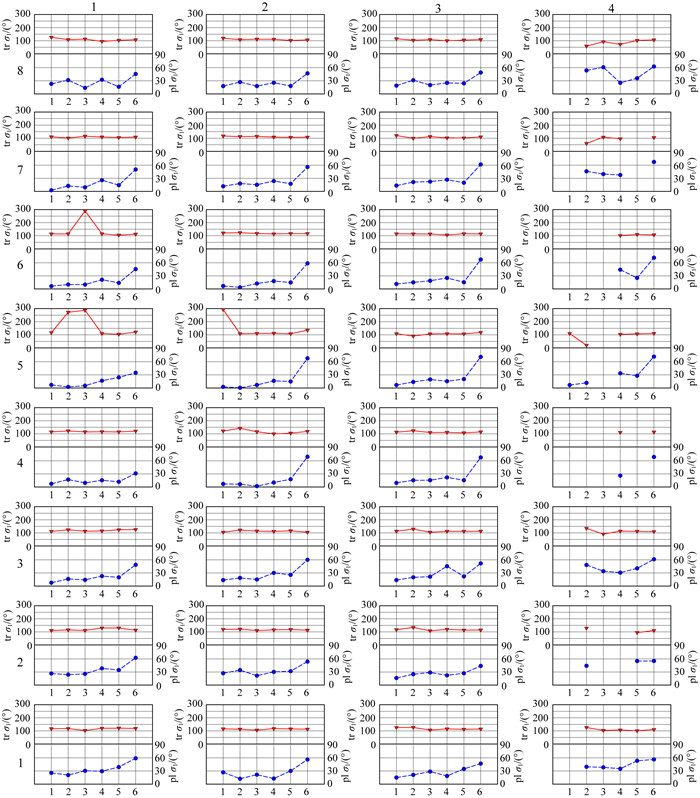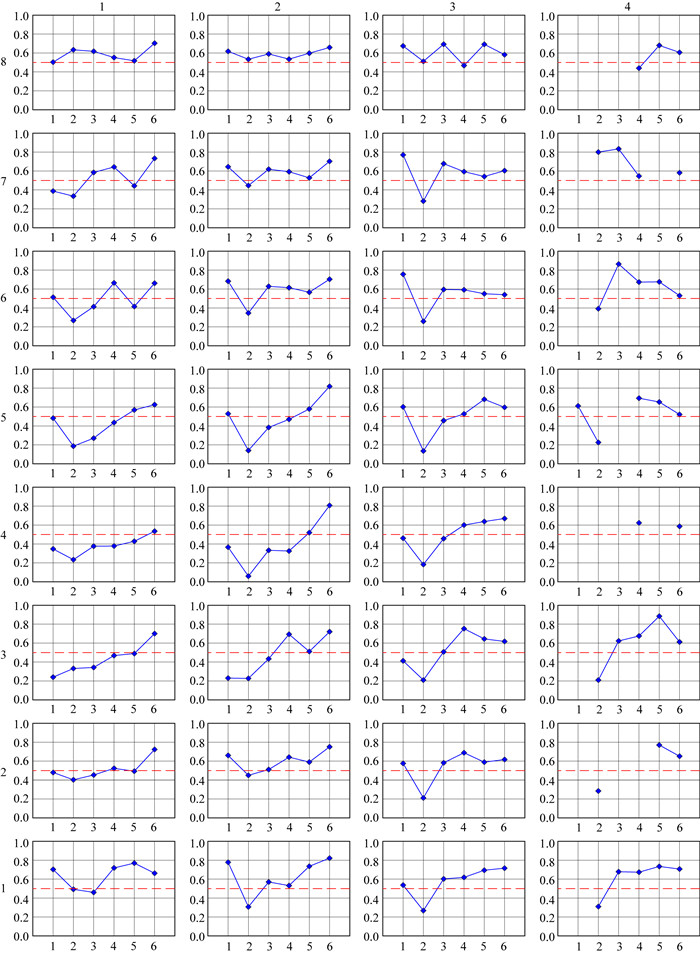The evolutionary analysis of the stress field in the seismic focal zone of the great Tohoku-Oki earthquake (MW=9.0) in the Japan Trench subduction zone
-
摘要:
于2011年3月11日发生在日本东北部的MW9.0级逆冲型板间地震是日本有地震记录以来震级最大的一次地震.本研究基于NIED F-net矩张量解目录中的震源机制解,选取两个长轴相互垂直的矩形区域进行应力场2D反演,获取了日本海沟俯冲带地区应力场的空间及时间分布图像.结果表明:主震前,俯冲带地区应力状态在空间上大体趋于一致,即应力轴(P轴、σ1轴及SHmax轴)系统性地倾向板块汇聚方向,P轴、σ1轴倾角整体偏缓(< 30°),且远离震源区及日本海沟东侧区域内的应力轴倾角普遍大于主震震源区内应力轴倾角;主震前,受2003年5月26日在宫城县北部发生的MW7.0地震影响,位于MW9.0地震震源区西北侧的应力场出现明显扰动,σ1轴倾向顺时针偏转150°~180°,并于之后大体恢复至震前状态,同期其他地区没有明显变化,这种情况可能和主震断层局部(深部)的前兆性滑动有关;主震后,距离震源区较远处应力场变化不大,主震震源区内应力场发生显著改变,P轴及σ1轴均以大角度(>60°)倾伏于板块汇聚方向,SHmax轴顺时针偏转60°~90°且在日本海沟附近普遍平行于海沟轴.这项研究以时空图像的方式展示了大地震前应力场变化的特点,反映了大地震孕震过程中构造与地震的相互作用,对于理解大地震孕震过程有重要意义.
-
关键词:
- 东日本MW9.0地震 /
- 日本海沟 /
- 俯冲带 /
- 震源机制解 /
- 应力反演
Abstract:The great Tohoku-Oki earthquake (MW=9.0) which occurred on 11 March, 2011 and ruptured the plate boundary between the subducting Pacific plate and the overlying continental plate was the best scientifically recorded earthquake in Japan so far. Focal mechanisms were collected from NIED CMT solutions, and then we selected two rectangle regions to perform 2D stress inversion to acquire spatial and temporal stress patterns of the seismic focal zone in the Japan Trench subduction zone. Before the mainshock, it could be inferred from the spatial distribution images that the stress state in the subduction zone was roughly uniform in space:P-axes, σ1-axes and SHmax-axes almost plunge with a low angle (< 30°) in the direction of plate convergence, and the plunges of P-axes and σ1-axes away from the seismic focal zone and at the east side of the Japan Trench are generally bigger than those in the seismic focal zone. Meanwhile, the stress field at the northwest side of the seismic focal zone (off the Miyagi Prefecture) is obviously disturbed by the 2003 Miyagi earthquake (MW=7.0) with an evident deflection at nearly 150° to 180° of the trend of σ1-axes, and then it returns to its previous state. Nevertheless, there is no significant change of the stress state elsewhere before the mainshock, which may be related to the precursory sliding of the mainshock fault at the deep front. After the mainshock, the stress field away from the seismic focal zone shows no evident change, while the change of the stress state in and around the seismic focal zone is remarkable. Stress axes including P-axes and σ1-axes plunge at a high angle (>60°) in the direction of plate convergence, and the SHmax-axes rotate clockwisely nearly 60° to 90° in the seismic focal zone and parallel to the trench axis around the Japan trench. This study shows the characteristics of the stress field variation before giant earthquakes in the form of temporal and spatial images, and reflects the interaction between the structure and earthquakes in the seismogenic process of great earthquakes as well, which is very significant for understanding the seismogenic process of great earthquakes.
-

-
-
Chen G Q, Wu Y Q, Jiang Z S, et al. 2013. Characteristics of seismogenic model of MW 9.0 earthquake in Tohoku, Japan reflected by GPS data. Chinese Journal of Geophysics (in Chinese), 56(3):848-856, doi:10.6038/cjg20130314.
Chiba K, Iio Y, Fukahata Y. 2012. Detailed stress fields in the focal region of the 2011 off the pacific coast of Tohoku earthquake-implication for the distribution of moment release. Earth, Planets and Space, 64(12):1157-1165. doi: 10.5047/eps.2012.07.008
Feng C J, Zhang P, Sun W F, et al. 2013. A discussion on the impact of Japan MW9.0 earthquake on the main active fault zone in north-and northeast-China continent and the seismic risk. Earth Science Frontiers (in Chinese), 20(6):123-140. http://en.cnki.com.cn/Article_en/CJFDTotal-DXQY201306021.htm
Ghimire S, Tanioka Y. 2011. Spatial distribution of stress and frictional strength along the interplate boundary in northern Japan and its correlation to the locations of large earthquakes. Tectonophysics, 511(1-2):1-13. doi: 10.1016/j.tecto.2011.08.004
Gou FJ, Miura S, Kodaira S, et al. 2013. Along-trench structural variation and seismic coupling in the northern Japan subduction zone. Earth, Planets and Space, 65(2):75-83. doi: 10.5047/eps.2012.06.003
Hao J L, Wang W M, Yao Z X. 2011. Source process of the 2011 MW9.0 Tohuko Japan earthquake. Science China Earth Sciences, 54(8):1105-1109, doi:10.1007/s11430-011-4241-y.
Hardebeck J L, Michael A J. 2006. Damped regional-scale stress inversions:methodology and examples for southern California and the Coalinga aftershock sequence. Journal of Geophysical Research:Solid Earth, 111(B11):B11310, doi:10.1029/2005JB004144.
Hardebeck J L. 2015. Stress orientations in subduction zones and the strength of subduction megathrust faults. Science, 349(6253):1213-1216. doi: 10.1126/science.aac5625
Hasegawa A, Horiuchi S, Umino N. 1994. Seismic structure of the northeastern Japan convergent margin:A synthesis. Journal of Geophysical Research:Solid Earth, 99(B11):22295-22311. doi: 10.1029/93JB02797
Hasegawa A, Yoshida K, Asano Y, et al. 2012. Change in stress field after the 2011 great Tohoku-Oki earthquake. Earth and Planetary Science Letters, 355-356:231-243. doi: 10.1016/j.epsl.2012.08.042
Heidbach O, Tingay M, Barth A, et al. 2010. Global crustal stress pattern based on the world stress map database release 2008. Tectonophysics, 482(1-4):3-15. doi: 10.1016/j.tecto.2009.07.023
Hiratsuka S, Sato T. 2011. Alteration of stress field brought about by the occurrence of the 2011 off the pacific coast of Tohoku earthquake (MW9.0). Earth, Planets and Space, 63(7):681-685. doi: 10.5047/eps.2011.05.013
Igarashi T, Matsuzawa T, Umino N, et al. 2001. Spatial distribution of focal mechanisms for interplate and intraplate earthquakes associated with the subducting pacific plate beneath the northeastern Japan arc:a triple-planed deep seismic zone. Journal of Geophysical Research:Solid Earth, 106(B2):2177-2191. doi: 10.1029/2000JB900386
Ikuta R, Satomura M, Fujita, A, et al. 2012. A small persistent locked area associated with the 2011 MW9.0 Tohoku-Oki earthquake, deduced from GPS data. Journal of Geophysical Research:Solid Earth, 117(B11):11408, doi:10.1029/2012JB009335.
Kanamori H, Stewart G S. 1978. Seismological aspects of the Guatemala earthquake of February 4, 1976. Journal of Geophysical Research:Solid Earth, 83(B7):3427-3434. doi: 10.1029/JB083iB07p03427
Katsumata K. 2011. A long-term seismic quiescence started 23 years before the 2011 off the pacific coast of Tohoku earthquake (M=9.0). Earth, Planets and Space, 63(7):709-712. doi: 10.5047/eps.2011.06.033
Koge H, Fujiwara T, Kodaira S, et al. 2014. Friction properties of the plate boundary megathrust beneath the frontal wedge near the Japan Trench:An inference from topographic variation. Earth, Planets and Space, 66(1):153. doi: 10.1186/s40623-014-0153-3
Lay T, Astiz L, Kanamori H, et al. 1989. Temporal variation of large intraplate earthquakes in coupled subduction zones. Physics of the Earth and Planetary Interiors, 54(3-4):258-312. doi: 10.1016/0031-9201(89)90247-1
Lin W R, Saito S, Sanada Y, et al. 2011. Principal horizontal stress orientations prior to the 2011 MW9.0 Tohoku-Oki, Japan, earthquake in its source area. Geophysical Research Letters, 38(7):L00G10, doi:10.1029/2011GL049097.
Lund B, Townend J. 2007. Calculating horizontal stress orientations with full or partial knowledge of the tectonic stress tensor. Geophysical Journal, 170(3):1328-1335. doi: 10.1111/gji.2007.170.issue-3
Martínez-Garzón P, Bohnhoff M, Kwiatek G, et al. 2013. Stress tensor changes related to fluid injection at The Geysers geothermal field, California. Geophysical Research Letters, 40(11):2596-2601, doi:10.1002/grl.50438.
Martínez-Garzón P, Kwiatek G, Ickrath M, et al. 2014. MSATSI:a MATLAB package for stress inversion combining solid classic methodology, a new simplified user-handling, and a visualization tool. Seismological Research Letters, 85(4):896-904. doi: 10.1785/0220130189
Ozawa S, Nishimura T, Suito H, et al. 2011. Coseismic and postseismic slip of the 2011 magnitude-9 Tohoku-Oki earthquake. Nature, 475(7356):373-376. doi: 10.1038/nature10227
Rebetsky Y L, Polets A Y, Zlobin T K. 2016. The state of stress in the earth's crust along the northwestern flank of the pacific seismic focal zone before the Tohoku earthquake of 11 march 2011. Tectonophysics, 685:60-76. doi: 10.1016/j.tecto.2016.07.016
Sato M, Fujita M, Matsumoto Y, et al. 2013. Interplate coupling off northeastern Japan before the 2011 Tohoku-Oki earthquake, inferred from seafloor geodetic data. Journal of Geophysical Research:Solid Earth, 118(7):3860-3869. doi: 10.1002/jgrb.50275
Shao Z G, Wu Y Q, Jiang Z S, et al. 2011. The analysis of coseismic slip and near-field deformation about Japanese 9.0 earthquake based on the GPS observation. Chinese Journal of Geophysics (in Chinese), 54(9):2243-2249, doi:10.3969/j.issn.0001-5733.2011.09.006.
Sheng Z S, Wan Y G, Cheng J, et al. 2012. Primary research on the coulomb stress triggering of the 2011 MW9.0 Tohoku earthquake. Seismology and Geology (in Chinese), 34(2):325-337. https://www.researchgate.net/publication/274526686_A_post-Tohoku_earthquake_review_of_earthquake_probabilities_in_the_Southern_Kanto_District_Japan
Shimazaki K. 1978. Correlation between intraplate seismicity and interplate earthquakes in Tohoku, northeast Japan. Bulletin of the Seismological Society of America, 68(1):181-192. https://www.researchgate.net/profile/Kunihiko_Shimazaki/publication/265435291_Correlation_between_intraplate_seismicity_and_interplate_earthquakes_in_Tohoku_Northeast_Japan/links/55964fb508ae21086d20a393.pdf?origin=publication_detail
Spence W. 1987. Slab pull and the seismotectonics of subducting lithosphere. Reviews of Geophysics, 25(1):55-69. doi: 10.1029/RG025i001p00055
Tan C X, Hu Q Y, Zhang P, et al. 2015. Present tectonic stress adjustment process before and after Japan MW9.0 earthquake in North and Northeast China and its research significance. Earth Science Frontiers (in Chinese), 22(1):345-359, doi:10.13745/j.esf.2015.01.030.
Umino N, Hasegawa A, Takagi A. 1990. The relationship between seismicity patterns and fracture zones beneath northeastern Japan. Tohoku Geophys. J., 33(2):149-162. https://link.springer.com/article/10.1186/BF03352553
Wang F, Shen Z K, Wang Y Z, et al. 2011. Influence of the March 11, 2011 Mw9.0 Tohoku-Oki earthquake on regional volcanic activities. Chinese Science Bulletin, 56(20):2077-2081, doi:10.1007/s11434-011-4523-y.
Wang K L, Hu Y, He J H. 2012. Deformation cycles of subduction earthquakes in a viscoelastic earth. Nature, 484(7394):327-332. doi: 10.1038/nature11032
Wang M, Li Q, Wang F, et al. 2011. Far-field coseismic displacements associated with the 2011 Tohoku-Oki earthquake in Japan observed by Global Positioning System. Chinese Science Bulletin, 56(23):2419-2424, doi:10.1007/s11434-011-4588-7.
Wang X S, Lü J, Xie Z J, et al. 2015. Focal mechanisms and tectonic stress field in the North-South Seismic Belt of China. Chinese Journal of Geophysics (in Chinese), 58(11):4149-4162, doi:10.6038/cjg20151122.
Wessel P, Smith W H F. 2013. New version of the generic mapping tools. EOS, 76(33):329. http://www.soest.hawaii.edu/pwessel/papers/1995/EOS_95/eos_95.html
Yin J R, Zhu Y Q. 2011. Preliminary discussion on distribution and dislacation mode of the fault for Ms9.0 Earthquake in Honshu, Japan. Journal of Geodesy and Geodynamics (in Chinese), 31(2):12-16. http://en.cnki.com.cn/Article_en/CJFDTotal-DKXB201102003.htm
Yoshida K, Hasegawa A, Okada T, et al. 2012. Stress before and after the 2011 great Tohoku-Oki earthquake and induced earthquakes in inland areas of eastern Japan. Geophysical Research Letters, 39(3):L03302, doi:10.1029/2011GL049729.
Zhang C, Zhang S X, Carminati E, et al. 2014. Thermal structure of Japan Trench subduction zone and deep-focus earthquakes. Chinese Journal of Geophysics (in Chinese), 57(10):3208-3217, doi:10.6038/cjg20141009.
Zheng J C, Wang P, Li D M, et al. 2013. Tectonic stress field in Shandong region inferred from small earthquake focal mechanism solutions. Acta Seismologica Sinica (in Chinese), 35(6):773-784. http://en.cnki.com.cn/Article_en/CJFDTOTAL-DZXB201306001.htm
陈光齐, 武艳强, 江在森等. 2013. GPS资料反映的日本东北MW9.0地震的孕震特征.地球物理学报, 56(3):848-856, doi:10.6038/cjg20130314. http://manu39.magtech.com.cn/Geophy/CN/abstract/abstract9332.shtml
丰成君, 张鹏, 孙炜锋等. 2013.日本MW9.0级地震对中国华北-东北大陆主要活动断裂带的影响及地震危险性初步探讨.地学前缘, 20(6):123-140. http://engine.scichina.com/doi/10.1360/N972015-00602
郝金来, 王卫民, 姚振兴. 2011. 2011年3月11日日本东北沿海MW9.0级地震震源破裂过程.中国科学:地球科学, 41(6):745-749. http://kns.cnki.net/KCMS/detail/detail.aspx?filename=jdxk201106002&dbname=CJFD&dbcode=CJFQ
邵志刚, 武艳强, 江在森等. 2011.基于GPS观测分析日本9.0级地震同震位错与近场形变特征.地球物理学报, 54(9):2243-2249, doi:10.3969/j.issn.0001-5733.2011.09.006. http://manu39.magtech.com.cn/Geophy/CN/abstract/abstract8159.shtml
盛书中, 万永革, 程佳等. 2012. 2011年日本9.0级大地震的应力触发作用初步研究.地震地质, 34(2):325-337. http://d.wanfangdata.com.cn/Periodical_dzdz201202011.aspx
谭成轩, 胡秋韵, 张鹏等. 2015.日本MW9.0级大地震前后华北和东北地区现今构造应力作用调整过程与研究意义探讨.地学前缘, 22(1):345-359, doi:10.13745/j.esf.2015.01.030.
王凡, 沈正康, 王阎昭等. 2011. 2011年3月11日日本宫城MW9.0级地震对其周边地区火山活动的影响.科学通报, 56(14):1080-1083. http://engine.scichina.com/doi/10.1360/N972015-00602
王敏, 李强, 王凡等. 2011.全球定位系统测定的2011年日本宫城MW9.0级地震远场同震位移.科学通报, 56(20):1593-1596. http://engine.scichina.com/doi/10.1360/N972015-00602
王晓山, 吕坚, 谢祖军等. 2015.南北地震带震源机制解与构造应力场特征.地球物理学报, 58(11):4149-4162, doi:10.6038/cjg20151122. http://manu39.magtech.com.cn/Geophy/CN/abstract/abstract11987.shtml
尹继尧, 朱元清. 2011.日本9.0级地震断层分布和错动方式探讨.大地测量与地球动力学, 31(2):12-16. http://www.cqvip.com/QK/95685A/201102/37550852.html
张晨, 张双喜, Carminati E等. 2014.日本海沟俯冲带热结构与深源地震.地球物理学报, 57(10):3208-3217, doi:10.6038/cjg20141009. http://manu39.magtech.com.cn/Geophy/CN/abstract/abstract10873.shtml
郑建常, 王鹏, 李冬梅等. 2013.使用小震震源机制解研究山东地区背景应力场.地震学报, 35(6):773-784. http://www.cqvip.com/QK/93548X/201306/47643604.html
-



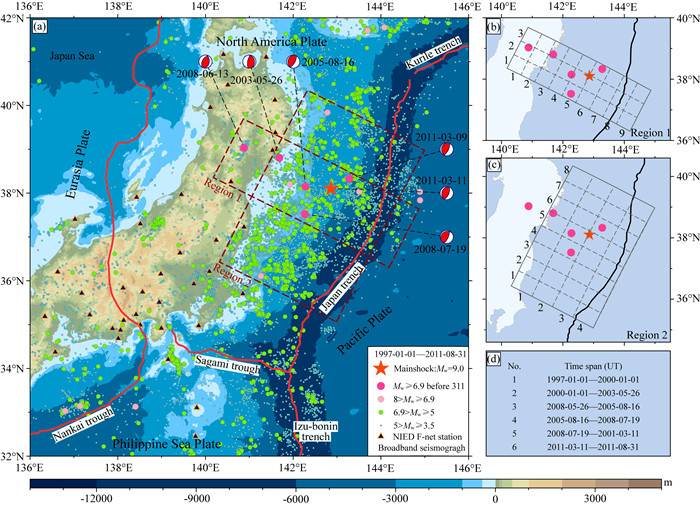
 下载:
下载:
